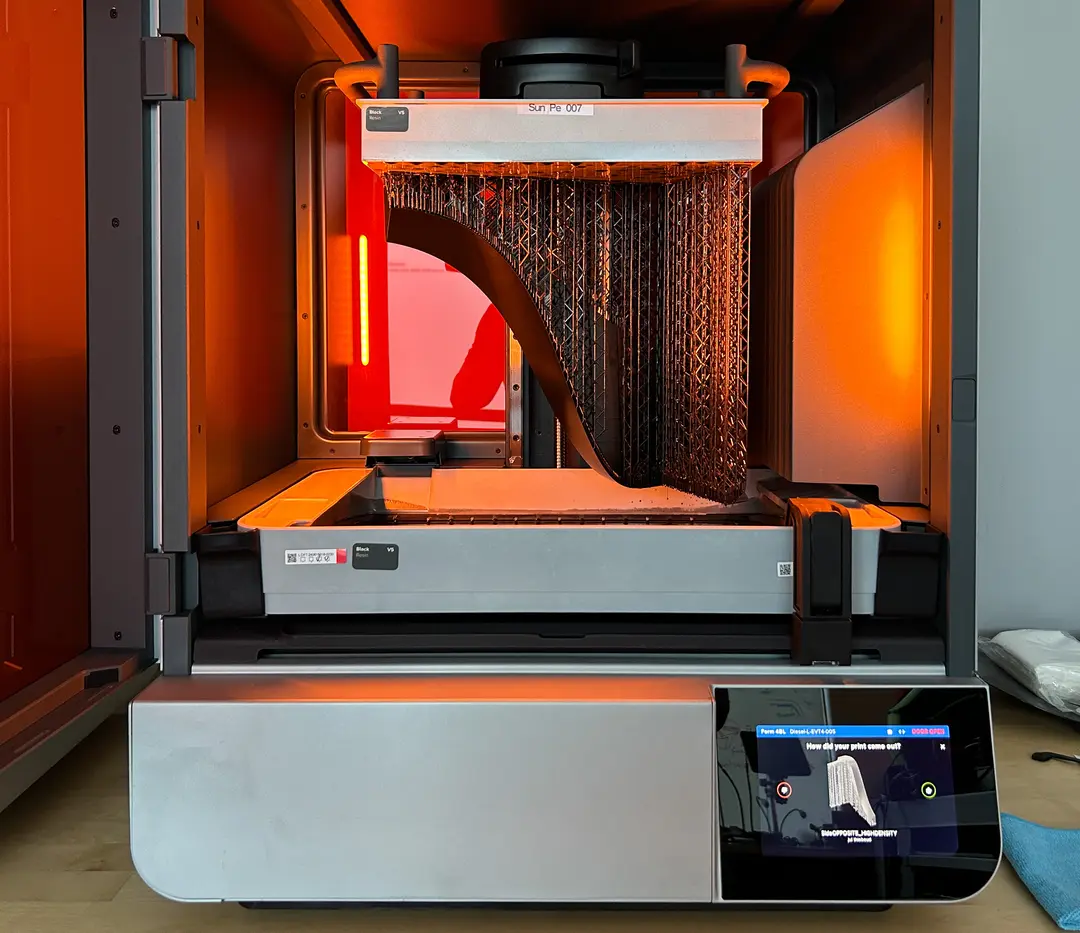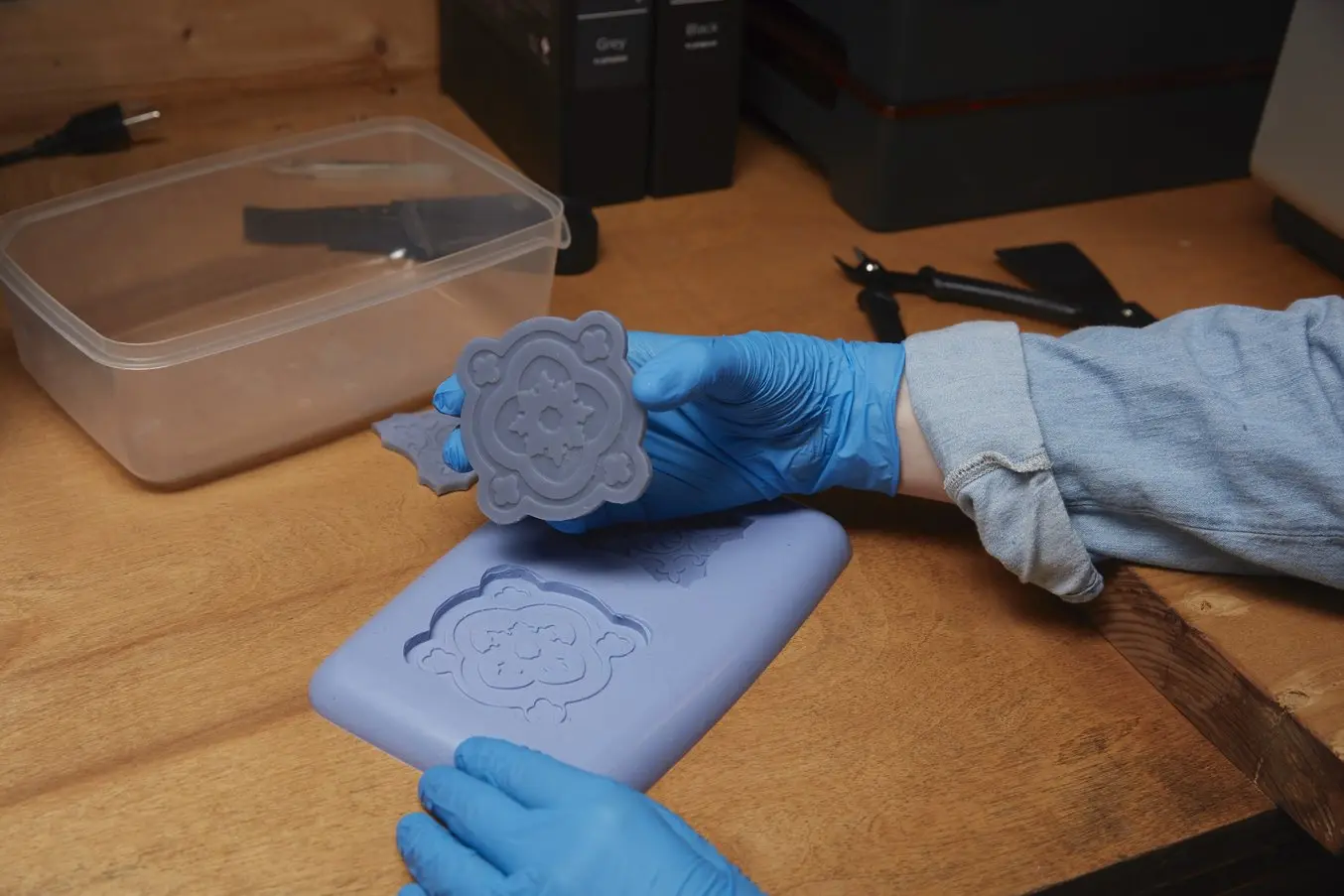
歴史上、職人たちは青銅器時代の武器から現代の消費財まで、あらゆるものを成形型を使って作ってきました。初期の成形型は石で成形するのが一般的でしたが、現代科学の発展により、シリコンのように加工がはるかに容易な材料が登場するようになりました。
現在、シリコン成形は数多くの産業で活用されています。製品開発者、エンジニア、DIYメーカー、そしてシェフまでもが、一点ものや少量生産の部品を作るためにシリコン成形型を利用しています。
この実用的なガイドでは、シリコン成形型を作り始める前に知っておくべきことをすべてご説明しています。必要な備品のリストとともに、あらゆるタイプのプロジェクトにシリコン成形を製作するためのステップバイステップの手順を解説します。
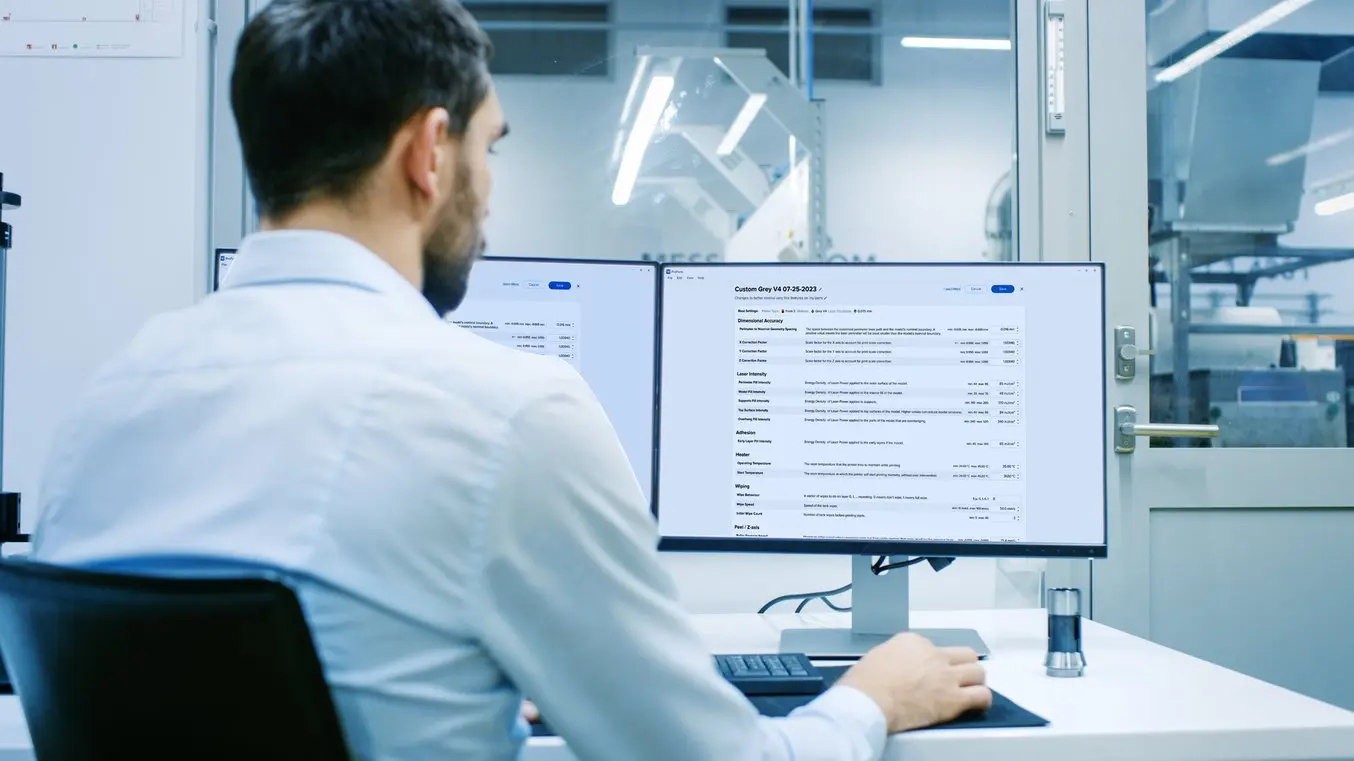
Formlabsへのお問合せ
試作品の高速製作も、実製品用部品の製造も、どのようなニーズにもお応えします。Formlabsは専門のスペシャリスト集団として、お客様や企業のニーズを的確にサポートします。
About Silicone
Silicones are a class of polymers that contain the element silicon in their molecular chain, and transform from a liquid (silicone) to a highly flexible and stretchable solid (silicone rubber) when reacted with a chemical catalyst.
In casting and mold-making, RTV silicone rubber captures fine surface details including embossed text. In addition, most castable silicones are not chemically adhesive, and will peel away from 3D printed molds after curing. Mechanical bonding can be achieved by casting onto highly porous surfaces like woven fabric, and in some cases chemical bonding can be promoted with specialized binders.
Liquid silicone: Liquid type silicones are typically two-part or a single part with a small amount of catalyst added. There are two general categories that are readily available. Platinum catalyzed silicones are higher cost but offer superior long-term dimensional stability and very low shrinkage after full cure. Tin catalyzed silicones are lower cost but less stable over time, and tend to have higher shrinkage rates. Curing time ranges from 10 minutes to several hours.
Silicone putty: This is a two-part putty in which components are blended together in equal amounts by hand. Key applications include mold making for the jewelry industry, however the silicone itself is a good mimic for compression molded gaskets or seals. It has a durometer rating of Shore 40A (see scale below), or a similar hardness to a pencil eraser. This silicone cures quickly in less than 20 minutes, and has zero percent shrinkage.
Skin, mucous membrane, and food safety: Some applications require more sensitivity than others when it comes to contact with the body or contact with food. Always check the materials safety data sheet (MSDS) from the silicone manufacturer to make sure the rubber is safe for your application.
Durometer rating scale: Rubbery materials, including silicone rubbers, can be formulated to a range of hardnesses from extremely soft to extremely firm, as indicated by a specific Shore durometer number. Softer materials are measured on the Shore A scale, and harder materials on the Shore D scale.
Adapted from Meridian Laboratory
シリコン成形型を選ぶ理由
シリコンが成形型製作の有力な選択肢となっているのは、多くの利点を備えている材料だからです。シリコン成形であれば、カスタムデザインを簡単に形にすることができます。シリコンで作った成形型はかなり頑丈なので、繰り返し使っても壊れる心配はあまりありません。有機材料であるゴムなどと違って、シリコンは無機物で構成している材料であるため、高熱や極寒環境、化学物質への暴露、さらにはカビに対しても強いという特性を持っています。シリコン成形型には、以下のような特長があります。
自由度
シリコンは柔軟性があるため、加工がしやすい材料です。シリコン成形型は、プラスチックのような硬い材質に比べてしなやかで軽く、成形後の取り外しも容易です。シリコンは柔軟性が高いので、成形型も加工品も壊れにくく、欠けにくいのが特徴です。複雑な工学部品から、ホリデーシーズンをテーマにしたアイスキューブやお菓子まで、特注のシリコン成形型を製作すればあらゆるものを成形することができます。
安定性
シリコンは、-65℃から400℃°までの温度に耐えることができます。さらに、配合によっては700%の伸び率を実現することも可能です。シリコン成形型は、オーブンに入れても、冷凍しても、取り出す時に伸ばしても、高い安定性を発揮します。
耐久性
多くの場合、シリコン成形型は何度も使い回しが可能です。しかし、成形型の寿命はものによって大きく異なることもあるので注意が必要です。鋳造の頻度が高いほど、また、デザインが複雑で細かくなればなるほど、成形型の劣化が早くなる可能性があります。シリコン成形型を最大限活用できるようになるためには、中性洗剤と水で洗浄し、十分に乾燥させ、積み重ねずに平らにして保管してください。
制約事項
シリコンを使うことで得られるメリットはたくさんありますが、注意しなければならない制限もいくつかあります。
-
シリコンは、ラテックスや有機ゴムに比べてコストが高く、Amazonで比較すると、1ガロンのシリコンは最高で100ドルが通常価格で、ラテックスのほぼ2倍です。
-
シリコンは弾力性がありますが、伸ばしすぎると破れることもあります。
-
すべてのシリコンが同じように調合されているわけではありません。シリコンや製造用材料を買う時は、必ず信頼できるサプライヤーから購入してください。
シリコン成形型の一般的な用途
シリコン成形型は、その汎用性と使いやすさから、ホビイストからプロフェッショナルまで幅広く利用されています。ここでは、シリコン成形型を作って製品を生産している業界や用途の例をいくつかご紹介します。
プロトタイピング
シリコン成形は、幅広い産業分野でプロトタイピングや製品開発用試作品の製作に活用されています。射出成形などの従来の製造工程で使用されるハードツーリングに比べてコストが大幅に低いため、製品設計検討用の試作品や新製品に対する市場や消費者の反応をテストするためのベータユニットの製作に最適です。3Dプリンタは1点物のパーツを素早く作るのに向いていますが、シリコン成形型やウレタン鋳造は少量生産のパーツに適しています。
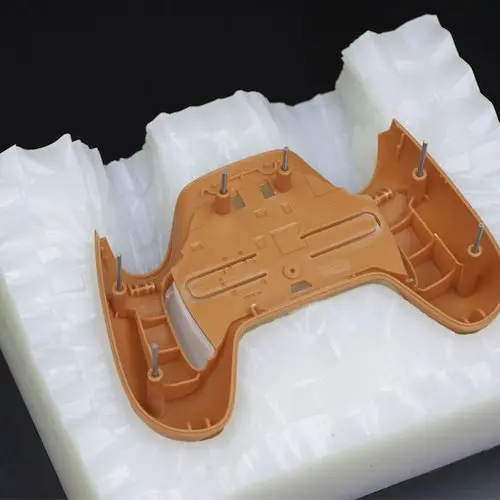
3Dプリンタとウレタンで量産移行前の成形型を生産
量産移行前に成形型を生産する方法は、従来の製造方法よりも高速なため、少量生産する製品や設計変更が必要になる可能性がある試作品の製作には有用です。このウェビナーでは、3Dプリントから生産量が中程度の場合の鋳造や射出成形への切り替え方法を解説しています。
ジュエリー
宝石商は、手彫りや3Dプリント製の原型をワックスで複製するために、特注シリコン成形型を使用します。これにより、新しい作品を作るたびにワックス彫りの原型を作成するという時間のかかる作業を段階的に減らすことができますし、ワックスからの鋳造も継続できます。これで連続生産の可能性が大きく開け、インベストメント鋳造を大規模に行うことも可能になります。シリコン成形型は細部まで再現できるため、華やかなディテールや複雑な形状の製品を作ることができます。
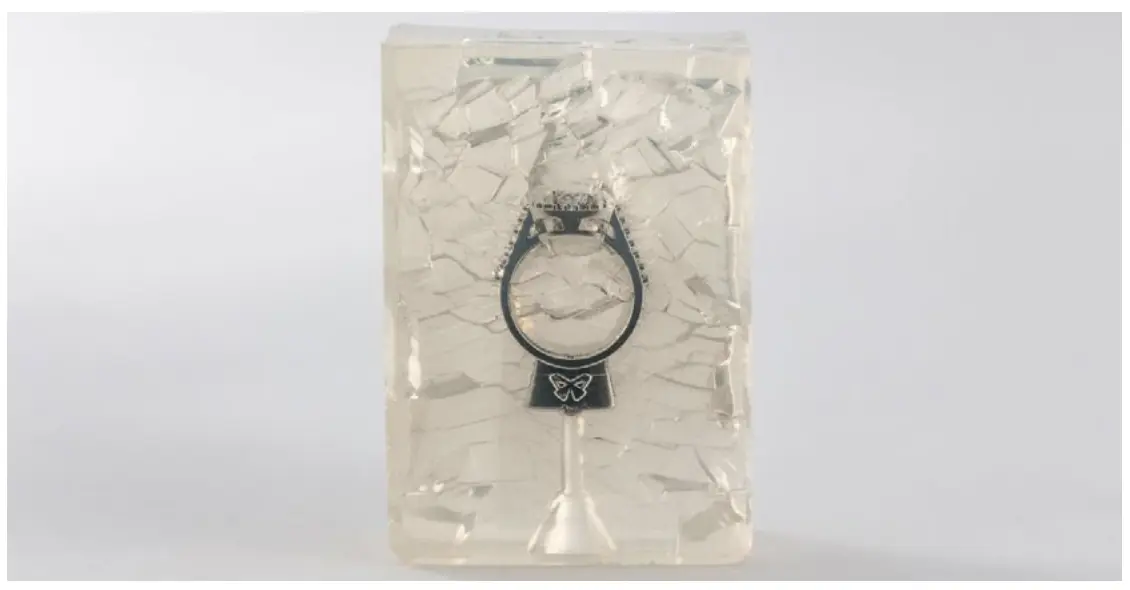
3Dプリント製原型の周りにRTV(室温加硫)シリコン成形型を形成。
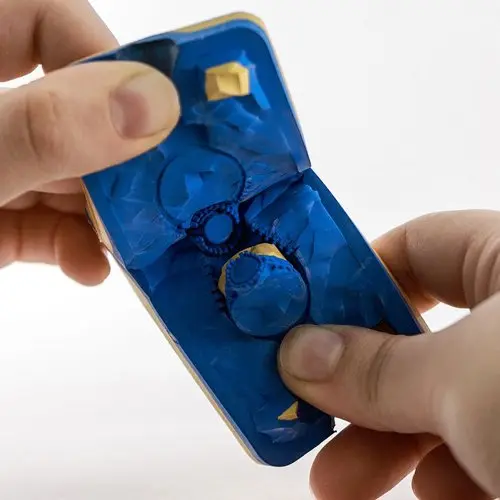
3Dプリント製の成形型で加硫ゴムを成形
高機能材料を使った3Dプリントにより、デザイナーや鋳造職人たちが生産工程でデジタル技術を活用できるようになります。ここでは、3Dプリンタで小型な金属部品を製作する方法について説明します。
消費者製品
シリコン成形型は、石鹸やキャンドルなど、手作り感のあるオリジナリティあふれる数多くの商品の製造に活用されています。学用品メーカーでも、チョークや消しゴムなどの成形にシリコン型がよく使われています。玩具や収集品のメーカーでも、この技術を使って高品質・高精度なミニチュアやカスタムフィギュアを製作しています。
例えば、SiOCASTは3Dプリント製の原型を使ってシリコン型を作り、3Dプリントとシリコン成形、射出成形を組み合わせたユニークな工程で生産を行っています。SiOCASTの技術は、小規模なスタジオからMonster Fight Club(The Witcher、Cyberpunk RED)、Reaper Miniatures(Bones)、Warlord Games(Blood Red Skies、Bolt Action)など業界最大手のミニチュアメーカーまで、すでに幅広く採用されています。
食品や清涼飲料
食品用シリコン成形型は、チョコレート、アイスポップ、ロリポップなど、あらゆる種類のお菓子作りに活用されています。シリコンは400℃の熱に耐えられるので、それで作られた成形型は料理にも使えます。マフィンやカップケーキなどの小さな焼き菓子は、シリコン成形型で焼くときれいに膨らみます。
DIYプロジェクト
独立したアーティストやDIYを趣味にする方々は、よくシリコン成形技術を使ってユニークな作品を創作しています。バスボムから犬用おやつまで、シリコン成形型で成形・再現できるアイテムはほぼ無限大です。子供向けには、自分の手のライフキャストを作る楽しいシリコン成形プロジェクトなどがあります。その際、肌に触れても安全なシリコンを選ぶようにしてください。

削減可能なコストと時間を算出
Formlabsの3Dプリンターでどれだけのコストと時間が削減できるのか、FormlabsのインタラクティブなROI計算ツールで是非ご確認ください。
シリコン成形用の原型の作り方
原型(原型)とは、シリコン成形型の凹面を精密に作るための型です。既存のオブジェクトを単に複製するのであれば、そのオブジェクトを原型として使用することが理にかなっているかもしれません。その際、成形型製作の工程に耐えられるものであることを確認するようにしてください。
新しいデザインやプロトタイプを作るには、まず原型を製作する必要がありますが、これにはいくつかのオプションがあります。シリコン成形用原型の作り方を、以下でいくつかご紹介します。
-
彫刻:粘土を使って原型を作ることができます。この方法は、彫刻の才能がある人だけでなく、比較的簡単なデザインを作りたいと思っている人でも容易に活用できます。原型を彫る作業は、子供たちにとっても楽しいプロジェクトになりますし、DIYをする人にとってはコストパフォーマンスの高い製作方法の一つです。
-
カービング:木から原型を作ることができます。木彫りの原型は、タイルやフラットなデザインを作るのに適しています。
-
3Dプリント:プロフェッショナルや商業デザイナーの多くは、3Dプリント製の原型を選びます。デスクトップ型3Dプリンタは、CADソフトにおけるデザインの自由度や、高い精度、試作品の修正のしやすさ、そして納期の短縮等、多くのメリットが得られます。
原型ができたら、シリコン成形型の製作に取りかかれるようになります。


シリコン型作りの基礎知識
シリコン成形型を作るために必要となる基本的な備品は、以下のとおりです。
-
原型
-
液状シリコン(Smooth-On OOMOO 30など)
-
成形型ハウジングのための箱または無孔性の容器
-
Smooth-Onのような汎用離型剤
-
ワックス、レジンまたはその他のエンドユース用材料
ワンピース型 vs 二つ割シリコン成形型
成形型の製作を始める前に、どのような型を作るかを決めておく必要があります。
ワンピースのシリコン型は、角氷の製氷皿のようなものです。型の中に液状の材料を充填し、固まるのを待ちます。しかし、角氷の製氷皿には面が平らなキューブ状の氷しかできないのと同じように、ワンピースの成形型は面が平らなデザインにしか対応できません。また、お使いの原型に深いアンダーカットがあると、シリコンが固まった後、原型や完成品を傷つけずに型から外すのが難しくなります。
そうしたことが気にならないのであれば、ワンピース型シリコン成形型は、原型の他のすべての面をシームレスに3Dで再現する理想的な方法だと言えます。

ワンピース型シリコン成形型は、側面が平らで、深いアンダーカットがないデザインに最適です。
平らな面がない、あるいはアンダーカットが深い3D原型を再現するには、二つ割シリコン成形型が適しています。二つ割では、成形型が2つに分割され、再び結合して充填可能な3Dキャビティを形成します(射出成形の仕組みに似ています)。
二つ割シリコン成形型は、平らな面が残らず、ワンピース型より作業しやすいところがあります。一方、製作するのが少々ややこしく、2つのパーツが完全に同一平面上にない場合、縫い目ができてしまう可能性があります。
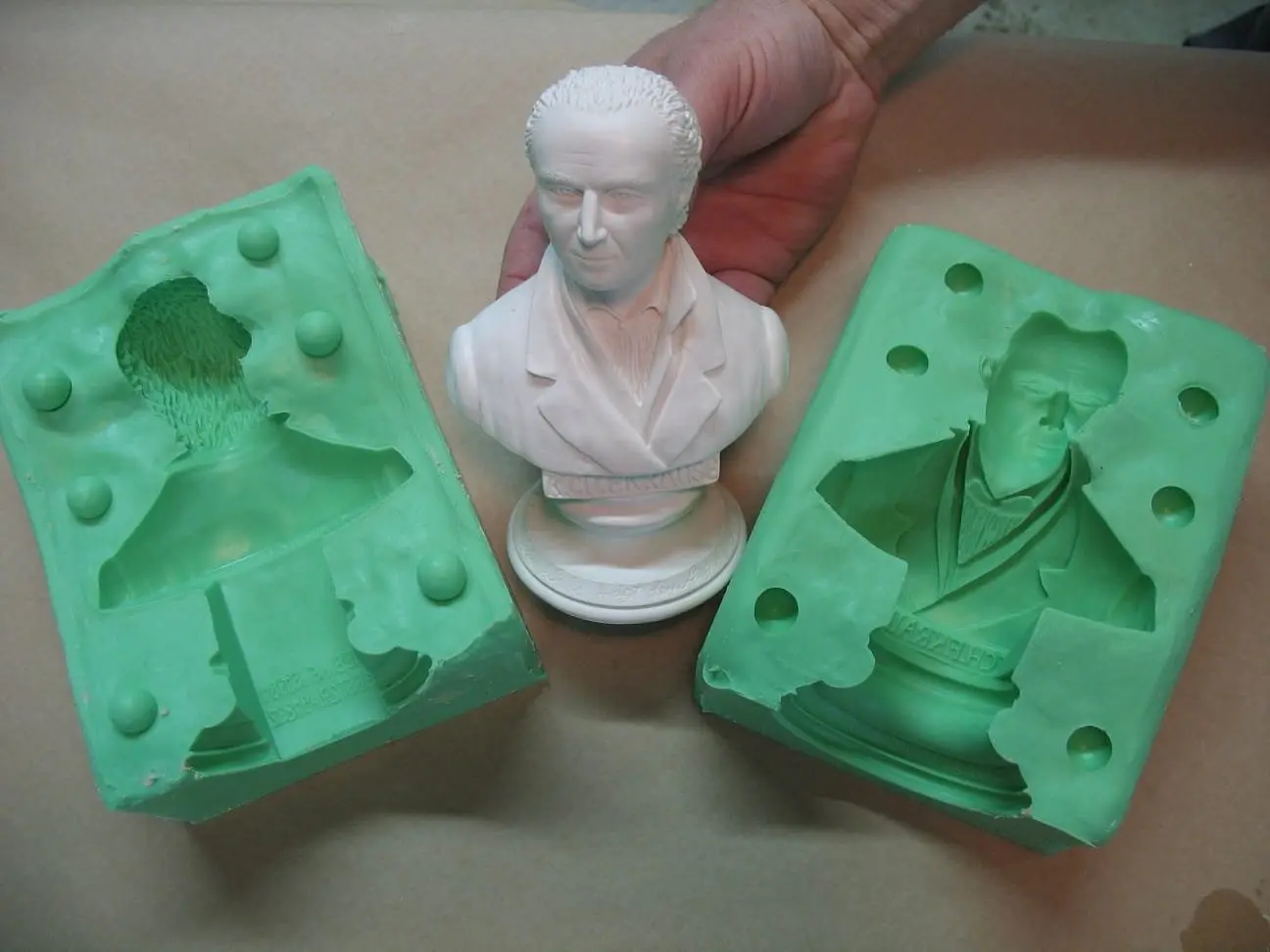
二つ割シリコン成形型は、どんな原型デザインでも再現できます(画像出典)。
シリコン成形型を選ぶ理由
まず、一体型(ワンピース型)か二分割型(二つ割)のどちらを使うかを決める必要があります。これらの成形型を作る工程は似ていますが、二つ割の成形型を作るには少し時間が長めにかかります。以下のステップバイステップの手順を踏めば、オリジナルのシリコン成形型を作ることができます。
ワンピース型シリコン成形型
-
オリジナルの製品原型を製作します。製品原型とは、デザインが最終的に固まった確定版のことで、他の材料でそのデザインを形にしていきます。SLA光造形方式の3Dプリンタで造形する場合、スタンダード系のレジンであればどれでも材料として使えます。その際、積層ピッチは50ミクロンに設定してください。細かなディテールがある面は、サポート材の痕が残らないようにしてください。造形品をIPAで念入りに洗浄します。表面に粘り気が残っていると、シリコン成形に影響が出る恐れがあります。
-
成形型のハウジングを製作します。シリコン成形型のハウジングを造る材料としては、コーティングされたMDFが一般的ですが、既製のシンプルなプラスチック容器でも十分です。無孔質で底が平らなものを探してください。
-
原型を広げて置き、離型剤を塗布します。まず、成形型のハウジングの内側に軽く離型剤を吹き付けます。原型をハウジングの中に敷き詰めます。並べる際、ディテールの凝った面を上にして置きます。ここでも離型剤を軽くスプレーします完全に乾くまで10分程度かかります。
-
シリコンを準備します。シリコンゴムをパッケージに記載されている方法で混ぜます。ハンディタイプの電動サンダーなどの振動装置を使えば、気泡を取り除くことができます。
-
成形型のハウジング内にシリコンを流し込みます。混合したシリコンゴムをハウジングにゆっくりと細めに流し込みます。まず、箱の一番低い部分(底面)を目指し、徐々に3Dプリント製の原型の輪郭に近づけていきます。1cm以上のシリコンで覆うようにします。硬化プロセスの長さは、お使いになるシリコンの種類やブランドによって異なりますが、だいだい1時間から1日程度で十分硬化します。
-
シリコンを離型します。硬化が完了したら、シリコンをハウジングから剥がし、原型を取り出します。これが最終製品を鋳造する時に使用する製氷皿スタイルの成形型になります。
-
鋳造作業を開始します。ここでも、シリコン成形型に軽く離型剤を吹き付け、10分ほど乾燥させると良いでしょう。キャビティに実製品用の材料(ワックスやコンクリートなど)を流し込み、硬化させます。
-
次の鋳造用の成形型を準備します。このシリコン成形型は複数回使用できます。ここまでのプロセスを繰り返したい時は、ステップ7まで戻り、そこから処理を再開します。
Best Practices
Resin selection: We recommend using Clear Resin to provide a visual queue for mold filling. We recommend printing with a 50 μm layer height for a good balance between smooth surface texture and fast printing time. Orient your parts on the build plate so that critical interior surfaces are free of support marks.
Alignment features: The four cylindrical bumps and divots at the corners of the mold are used as alignment features to ensure proper registration between the two sides of the mold. Our partner recommends adding 0.1 mm of clearance for alignment features.
In a rotationally symmetric object like this gasket, the alignment features can have identical shape and placement. In other words, the top of the mold can be rotated 90 or 180 degrees, and the gasket shape is not affected. For irregular geometries, a lock and key strategy can be used, in which the shape and placement of the alignment features can only come together in one unique way.
Beveled pry points: Adding chamfers to the mold edges can make it easier to pry apart the two sides of the mold To pry apart the mold, you can use the spatula that comes with the Formlabs Finish Kit, or a flat head screwdriver
Mold design: One of the first design features that you need to consider is the parting line of the mold, or how the two parts of the compression mold come together, and how they come apart.
二つ割シリコン成形型
二つ割の成形型を作るには、まず上記の最初の2つのステップ、つまり原型の作成と成形型の筐体の製作から始めます。その後、下記のプロセスを通じて二つ割の成形型を作成していきます。
-
粘土の中に原型を敷き詰めます。この粘土を使って、最終的に成形型の半分になるものを作っていきます。粘土を成形型の筐体の中に入れ、原型の半分が粘土からはみ出るようにします。
-
シリコンを準備して注入します。シリコンのパッケージに記載されている方法に従って、シリコンを準備し、成形型のハウジングにゆっくり注ぎ、粘土と原型の上をシリコンで覆います。このシリコンの層が、二分割のうちの1ピース、つまり成形型の半分を構成します。
-
成形型の筐体からすべて取り出します。最初のピースが一旦硬化したら、成形型のハウジングからそのピース、原型や残りの粘土を取り出す必要があります。抽出時に層が分離しても大丈夫です。
-
粘土をきれいに取り除きます。粘土をすべて取り除くと、最初のシリコン成形型と原型が現れます。原型と既存の成形型が完全にきれいになっていることを確認してください。
-
成形型と原型を成形型のハウジングに戻します。既存のシリコン成形型と原型(成形型にセットされている)の両方を、成形型のハウジングに上向きに挿入し直してください。
-
剥離剤を塗布します。原型と既存のシリコン成形型の上部に離型剤を薄く塗ると、脱型が容易になります。
-
成形型の2つ目のピースに使うシリコンを準備し、流し込みます。先ほどと同じ要領で、準備したシリコンを成形型のハウジングに流し込んで、成形型の2つ目のピースを作ります。
-
成形型の2つ目のピースが硬化するのを待ちます。時間をかけて成形型の2つ目のピースが硬化するのを待ちます。硬化するまでは、成形型のハウジングから取り外そうとしないでください。
-
パーツを離型します。成形型のハウジングからシリコン成形型の両ピースを取り出し、ゆっくりと引き離します。

OXO used a two-part mold to prototype this cocktail shaker gasket. Learn more about the compression molding process they used here.
Best Practices
Resin Selection: General Purpose Resins such as Grey Resin capture high surface detail. Silicone picks up fine details in the surface, including layer lines. While 50 micron layer height provides a good balance between smooth surface and print speed, printing at 25 micron layer height might be appropriate for some aesthetic applications.
Mold Release: It is important to use this in both stages of your molding process, such as in the creation of the silicone mold, as well as the casting of the end-use part. The Smooth-On brand makes a multipurpose mold release which works well for most applications.
Draft Angles: The silicone molding process is fairly forgiving and can handle 90 degree angles or light undercuts. If you plan to use the mold multiple times, try to minimize the amount that you need to flex and stretch the mold to release your parts, or seek out a silicone rubber formula with a high tear strength.
Silicone Overmolding

Dame Products employs silicone overmolding in production and to encapsulate internal hardware for customer beta prototypes.
Silicone overmolding is used to encapsulate hardware within a layer of silicone, like the handle of a tool or a medical appliance.
- Print multipart mold in Formlabs Clear Resin: Printing with 50 μm layer height isrecommended. Orient parts so critical interior surfaces are free of support marks. Clear Resin enables you to see the interior of the mold while it is being filled.
-
Wash and Cure the mold, and remove supports: Wash thoroughly with IPA until the parts have a non-tacky finish. Once washed and dried, post-cure the parts in Form Cure.
-
At least one hour in advance: Prepare silicone: Fill each side of the epoxy cartridge system with one part (A or B), using separate syringes to transfer the liquids. Stand upright and allow silicone to gently degas for at least one hour, or up to one day. An optional step here is to add dye to either the A or B side of the cartridge and mix thoroughly.
-
Apply Mold Release (optional): Apply a very light layer of petroleum jelly to the internal surfaces of the mold with a small paint brush. This silicone overmolding technique also works without mold release.
-
Orient internal hardware: The alignment pins on the mold aid the positioning of the hardware.
-
Close the mold, and compress it by hand: Check the placement and alignment of the hardware through the exterior of the mold. If the hardware appears out of alignment, repeat steps five and six.
-
Clamp the mold: Start by clamping in the “direction of draw” or perpendicular to the main parting line of the mold. It’s a good idea to check alignment again, since clamping may shift the internal hardware. As an optional step, sealing the edges with duct tape prior to clamping can help reduce any material seepage and flashing that occurs in RTV mold making.
-
Assemble the epoxy gun: Insert the cartridges into the gun and screw on the mixing nozzle. It’s helpful to squeeze a little bit of liquid out of the nozzle tip at this stage to make sure you are getting proper mixing.
-
Inject silicone into the mold: Insert the tip of the mixing nozzle into the mold opening and squeeze the trigger gently. Watch the silicone flow through the mold, and continue to pump until the mold is full and silicone is coming out of all of the vent holes. If silicone continues to sink into the mold after you’ve stopped, that’s because air bubbles are settling or material is seeping at the parting lines. You may need to add a little more a few times after initial fill. After filling, holding a vibrating device (such as a handheld sander) to the surface of the mold can encourage evacuation of air bubbles.
-
Wait for the silicone to cure: Check your silicone instructions for recommended curing time.
-
Demold the prototype: Cut all excess silicone off the exterior of the mold first. Then pry apart the mold with the Formlabs spatula or a flat head screwdriver. Be mindful of thin strings of silicone that form in the mold air vents. Take your time to trim these separately so they do not stay with the mold and pull the silicone off of your hardware. It can also be helpful to trim away some flashing before the object is completely released.
-
Trim, finish, and clean the prototype: There will always be flashing to trim off with the Formlabs Flush cutters or a sharp blade. If any air bubbles create voids on the surface, you can paint on additional liquid silicone patches and allow them to cure. Prototypes should be cleaned using industry-specific guidelines before they are handled by beta testers.
-
Prepare mold for the next casting: The mold can be re-used multiple times, but you may need to clean out air vents using a sharp object such as a paper clip or drill bit. Return to Step four above.
シリコン成形技術で広がる可能性
結局、食品でもフィギュアでも業務用部品でも、作り方は一つだけではありません。最良の結果を得るために、様々な生産方式を併用することが一般的です。それぞれ独自の長所と短所をすべて理解しておくと、プロジェクトにとって最適な決断が下しやすくなります。
シリコン成形型の製作の技術や用途についてさらに詳しくご覧になりたい場合は、Formlabsの技術資料「シリコン成形で製品設計」をダウンロードしてご確認いただけます。


